Monetizing Content Through API for LLM Training
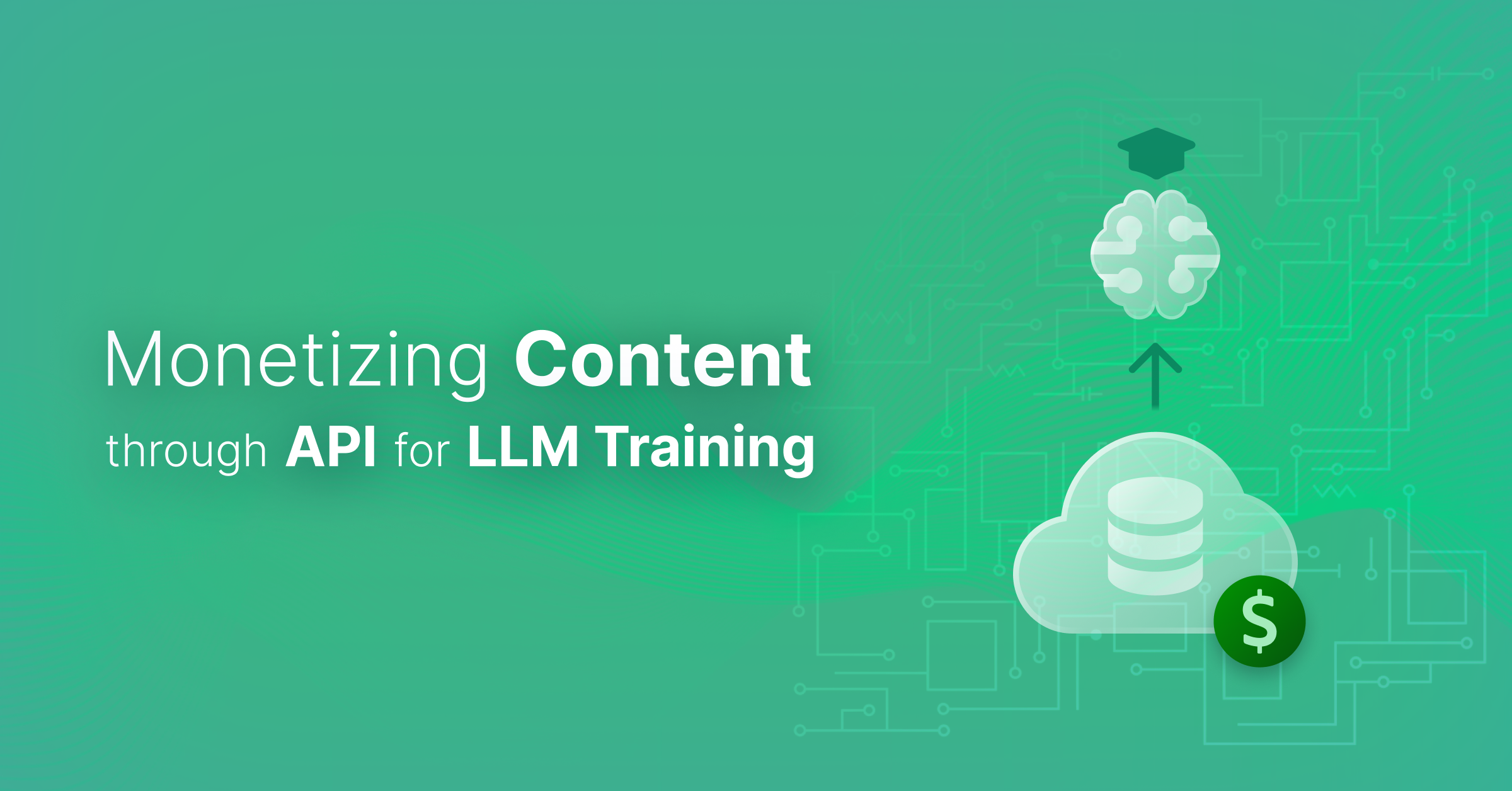
To monetize digital content, we have used means like ad networks, affiliate links, and paywalls. However, with the fast and widespread adoption of AI, demand for high-quality data has increased. To make sure Large Language Models (LLMs) models deliver value and accurate results, a wide spectrum of content is often scraped and trained on without permission or compensation. This includes blogs, product and technical docs, forums, and research papers.
Organizations now have the opportunity to treat their content not just as a marketing asset, but as a licensable product. The future of content monetization lies beyond ads and subscriptions, in providing structured, API-based access for machine learning. This unlocks a powerful revenue stream and adoption of new business models by allowing AI developers to pay for the high-quality, domain-specific data they need. Platforms like Moesif can provide the critical infrastructure to track, meter, and bill for that access, making sure creators receive compensation for the true value of their work. Oxford University Press (OUP), for example, has taken this approach and successfully leveraged Moesif to monetize their content.
 Productize and Monetize Your Content Through API
14 day free trial. No credit card required.
Try for Free
Productize and Monetize Your Content Through API
14 day free trial. No credit card required.
Try for Free

Why Monetize Content in the LLM Era?
The fundamental value of digital content has expanded beyond human readership. The rise of LLMs has transformed your existing content repositories into highly valuable training data. Companies developing AI models require vast, diverse, and high-quality datasets to improve model accuracy and relevance and get rid of hallucinations. And your unique content is a prime source for this material. This has substantiated a new, direct, and scalable revenue opportunity that didn’t exist just a few years ago.
Traditional monetization strategies like display ads, affiliate marketing, or even standard paywall subscriptions don’t align with this new demand. An AI model doesn’t click ads or appreciate a premium user experience; it needs raw access to the underlying information. This has paved the way for API monetization to emerge as the crucial supplement to older methods. It allows you to package and sell your content as a data product specifically for machine consumption, shifting from simply monetizing human attention.
We have observed major content platforms already proving this trend. For example, Stack Overflow and Reddit have established paid API tiers specifically for large-scale data access, allowing AI companies to legally and ethically train their models on high-quality conversational and technical data. Similarly, specialized data providers like LexisNexis have long monetized their curated legal and news archives through data licensing deals. These examples demonstrate a clear market validation: significant demand exists as well as willingness to pay for structured access to quality content for LLM training.
For example, StackOverflow offers OverflowAPI to allow LLMs and AI product (like generative AI) developers to access StackOverflow’s vast dataset. Reddit also enforces commercial agreements for LLM training on their data, like Google’s partnership deal.
The Value of Quality Content for Large Language Model Training
The core drivers of value in content are accuracy, coverage, and structure. LLM developers seek content that reflects real-world knowledge, adheres to domain-specific terminology, and captures context that models can generalize from.
Domain Authority
LLM training pipelines often filter data sources for credibility and relevance before ingestion. That means your content needs to be both present online and trusted. For example, a structured medical terminology database with treatment protocols and peer-reviewed references carry more weight in training than loosely written health articles with anecdotal advice.
Format and Structure
Training systems can efficiently parse and tokenize content that consistently follows a clean format, whether in HTML, Markdown, or JSON. Moreover, metadata like timestamps, author identifiers, tags, and semantic markup increases the dataset’s utility since it enables filtering, deduplication, and targeted training. For example, a product documentation API that tags functions, parameters, and return values makes it easy to create fine-tuned programming assistants.
Coverage and Diversity
A dataset that contains multiple perspectives, languages, or formats allow a model to generalize better. They also support training models with broader comprehension and reasoning skills. LLM engineers often actively seek out diverse but coherent content collections to reduce bias and increase the model’s robustness.
Consistency Over Time
Models benefit from content that’s regularly updated and historically versioned. This allows training teams to construct temporal datasets, so that models learn both current and historical context. If your content updates in predictable ways, you can expose it through a versioned API. This increases your content’s appeal to model vendors who want to retrain without rebuilding entire pipelines.
Common Forms of API-Based Content Monetization
Once you have decided to monetize your content through API, you must select the right pricing model. The best strategy depends on a number of things, for example:
- The nature of your content
- The target audience of LLM and AI-product developers and their requirements
- Your business model and goals.
Taking a hybrid approach to mix different content monetization models can also prove very practical depending on your scenario.
Subscription or Tiered Pricing
This is a very common and predictable model, offering access to your API for a recurring fee. It allows you to design your tiers to segment your customers—from small teams to large enterprises. Every customer has a clear path to upgrade if necessary.
Here’s how the tiers might look:
- Free/Developer tier: Offers a limited number of requests or tokens per month at no cost. This tier lowers the barriers to entry. Potential customers can experiment and validate your content’s utility to determine whether or not it suits their models.
- Pro/Business tier: Offers significant higher usage quotas, access to more valuable or recent data, and standard support. It suits small to medium-sized teams actively training LLM models.
- Enterprise tier: Features custom pricing, very high or unlimited usage quotas, premium support (SLAs), and potentially more flexible licensing terms for derivative works. This tier supports large enterprises or commercial AI operations.
Moesif can help enforce rate limits, trigger alerts based on usage thresholds, and track how often enterprise customers hit their quotas. Having such control and data means your organization can perform renegotiations and upsell higher tiers.
Usage-Based Pricing
This model directly ties cost to consumption. Developers find this fair and reliable since they only pay for what they use. Projects that deal with unpredictable or fluctuating data needs will find this model very ideal.
You can implement a usage-based model in different ways, for example:
- Per API call: Charging for each call to the API a fixed amount. This works well when the responses have uniform or predictable size and value, and incurs consistent computational cost.
- On content volume: Charging based on the volume of data transferred. It provides an equitable way to charge when your payloads vary greatly in size and value, like images or full document workloads.
One possible caveat is that while small use cases appreciate paying for what’s used, enterprises may view pay-per-call as unpredictable. Moesif can provide a decisive advantage here through its powerful product and customer analytics tools. If you have definitive insights into consumption patterns and customer behavior, you can confidently strategize your billing meters and pricing.
Outcome-Based Pricing
An outcome-based pricing model aligns your pricing structure directly with the value or computational unit relevant to your customer. For example:
- You can charge a flat rate for each individual document analyzed or retrieved, like a financial report or news article.
- Charging for successful delivery and validation of a dataset
- Charging for each tokenized word or sentence; it aligns with how LLM pipelines measure training data at scale
Another example can be data transformation: if your API enriches or cleans raw data, you can price by successful transformation.
An outcome-based scheme might prove harder to implement since outcomes often occur downstream of the request itself. However, Moesif’s high-cardinality and high-dimension analytics can easily help you capture those outcome events, which you can then make use of in the billing meter logic.
Dynamic Pricing by Content Type
Dynamic pricing acknowledges the heterogeneity of content:
- A general news editorial may have a base price per request
- A peer-reviewed research paper with structured metadata has more value and therefore is more expensive
To make this model work, you need to appropriately tag the content so the billing infra can accurately identify what content the API delivered. With Moesif, you can attach any custom metadata to your API events; they become available in a dedicated Metadata field in the UI.
Dynamic pricing can maximize revenue; it also prevents undervaluing niche, high-quality content that carry disproportionate importance for model training.
Metering and Charging for API Access: How Moesif Can Help
LLMs consume millions of records or gigabytes of data. Without precise measurement, you will either undercharge and lose revenue, or overcharge and lose customers.
Define Billable Units
First decide what counts as a billable metric or event. For example:
- A finance API might bill per row of historical stock market data.
- A dictionaries API might charge for each requested dictionary entry.
You can include custom fields and metadata to your API events that can help you track these chargeable units. In the following example, Live Event Log shows real-time API events for CSV exports in a content API. Notice that it also filters out unsuccessful export jobs.
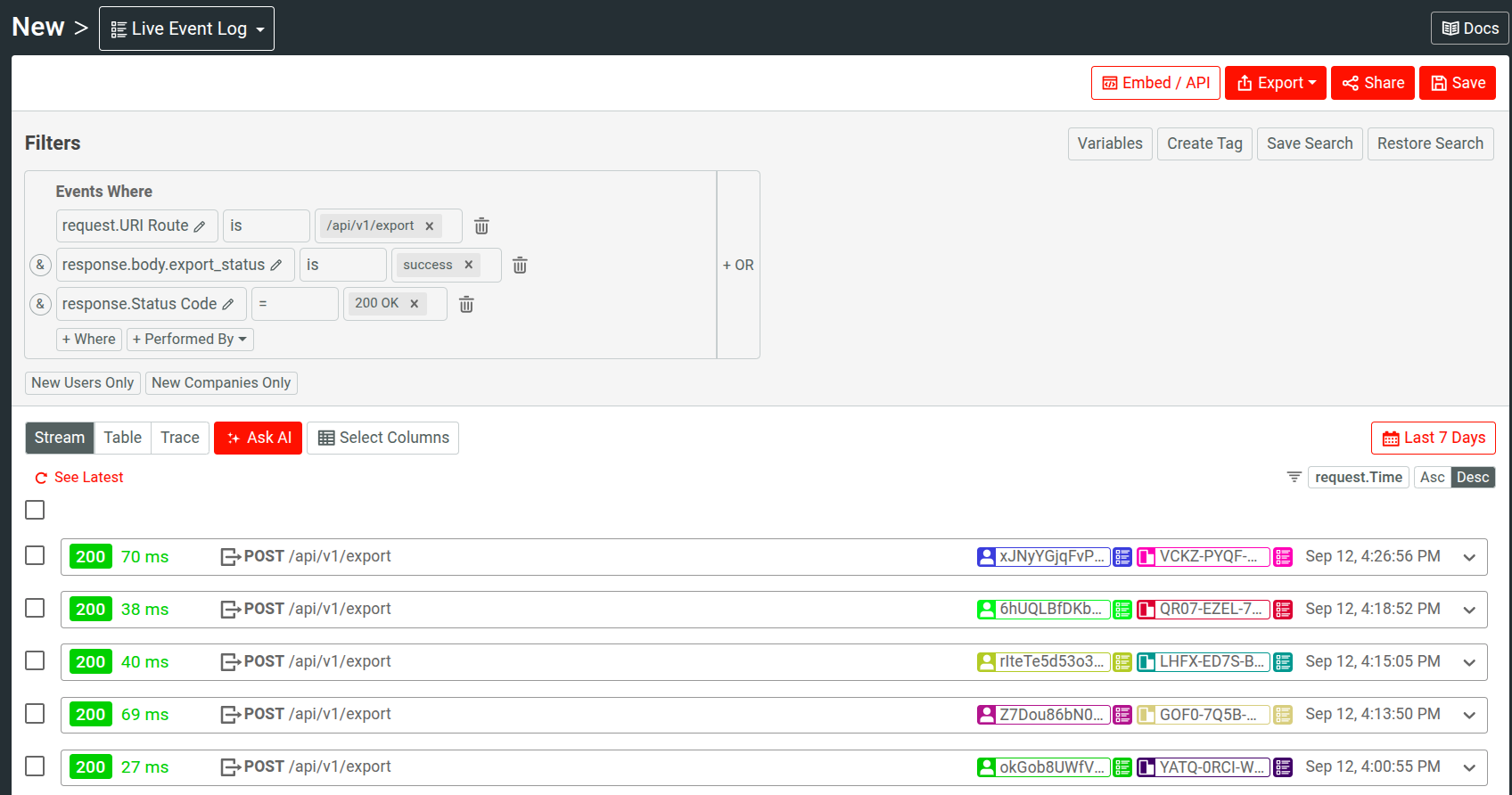
Inspecting API traffic helps you pinpoint the chargeable unit and verify whether you have sufficient instrumentation to capture that data.
Convert Requests into Metered Usage
After you have enriched your API events with contextual information to help track billable units, use Moesif Billing Meters to track, meter, and charge your customers for their usage. Billing Meters allow you to define the usage metric you want to bill on, with fine-grained filters to only consider events that matter.
For example, consider an API that associates a document ID for each document requested. You can think about the pricing in two ways:
- Per API call
- Per content volume
To charge customers 1 USD for each 1k successful API calls, you can create the following billing meter:
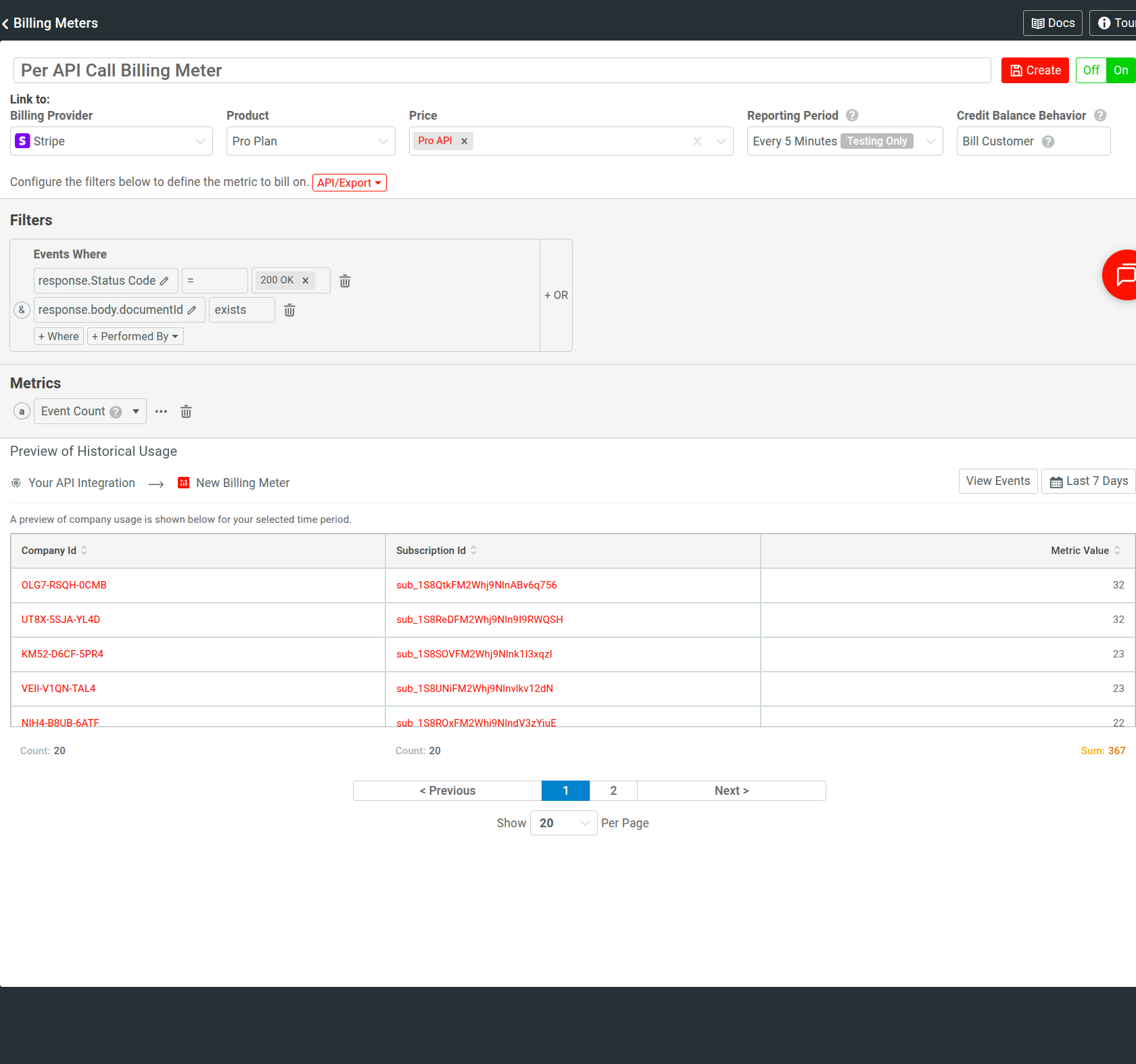
For the latter strategy, you can change the billable metric from Event Count to events having distinct document IDs:
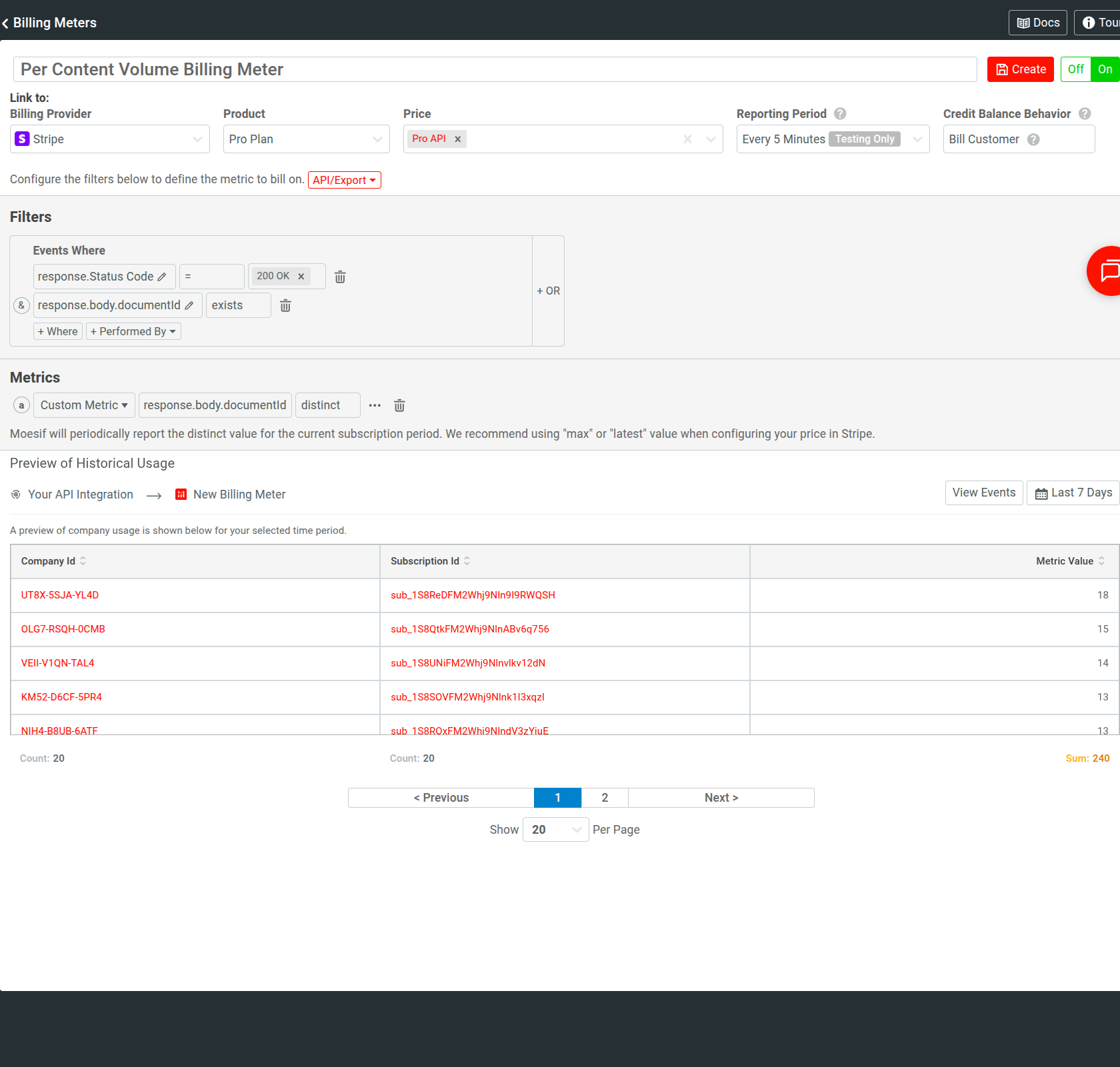
This meter has several benefits over the other:
- Counts only distinct document ID values, thereby ignoring duplicate fetches
- Meters and charges appropriately when responses have multiple documents
Both meters include pricing information:
- The plan or tier
- The price associated with the plan or tier
The Pro API price in this example configures the following about how to charge customers:
- Charge 1 USD for each 1k units of billable metric
- Use a Stripe Meter to measure usage by adding up each month’s usage
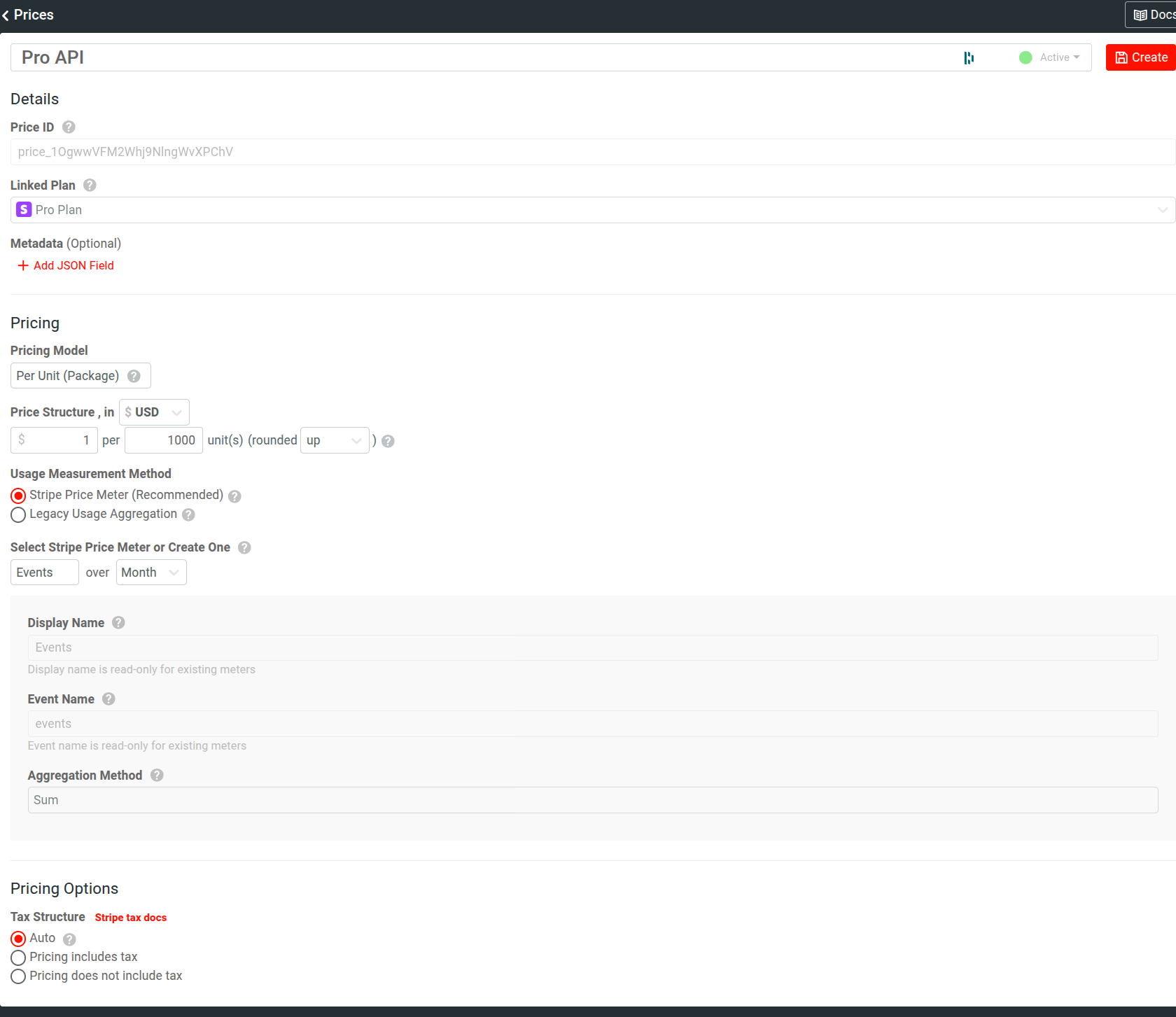
The billing meter shows each company’s usage in the past 7 days under their respective subscription plans. So a metric value of 18 means they have a bill of 18 USD so far.
Enforce Quotas Automatically
Enterprises expect hard and definite guardrails around consumption, more so when LLMs train on their data. Moesif compliments your gateway-specific guardrails and enforcements by allowing you to administer quotas and governance rules for complex, longer-term, and business-specific requirements. For example, a basic tier might allow 50k requests per month, while enterprise customers get custom limits. Moesif can trigger alerts when a customer exceeds a monthly quota, block additional requests, and inform customers to upgrade or refill credits.
Here, a quota rule blocks premium plan users once they cross 10k requests in a billing period; the response also provides useful context:
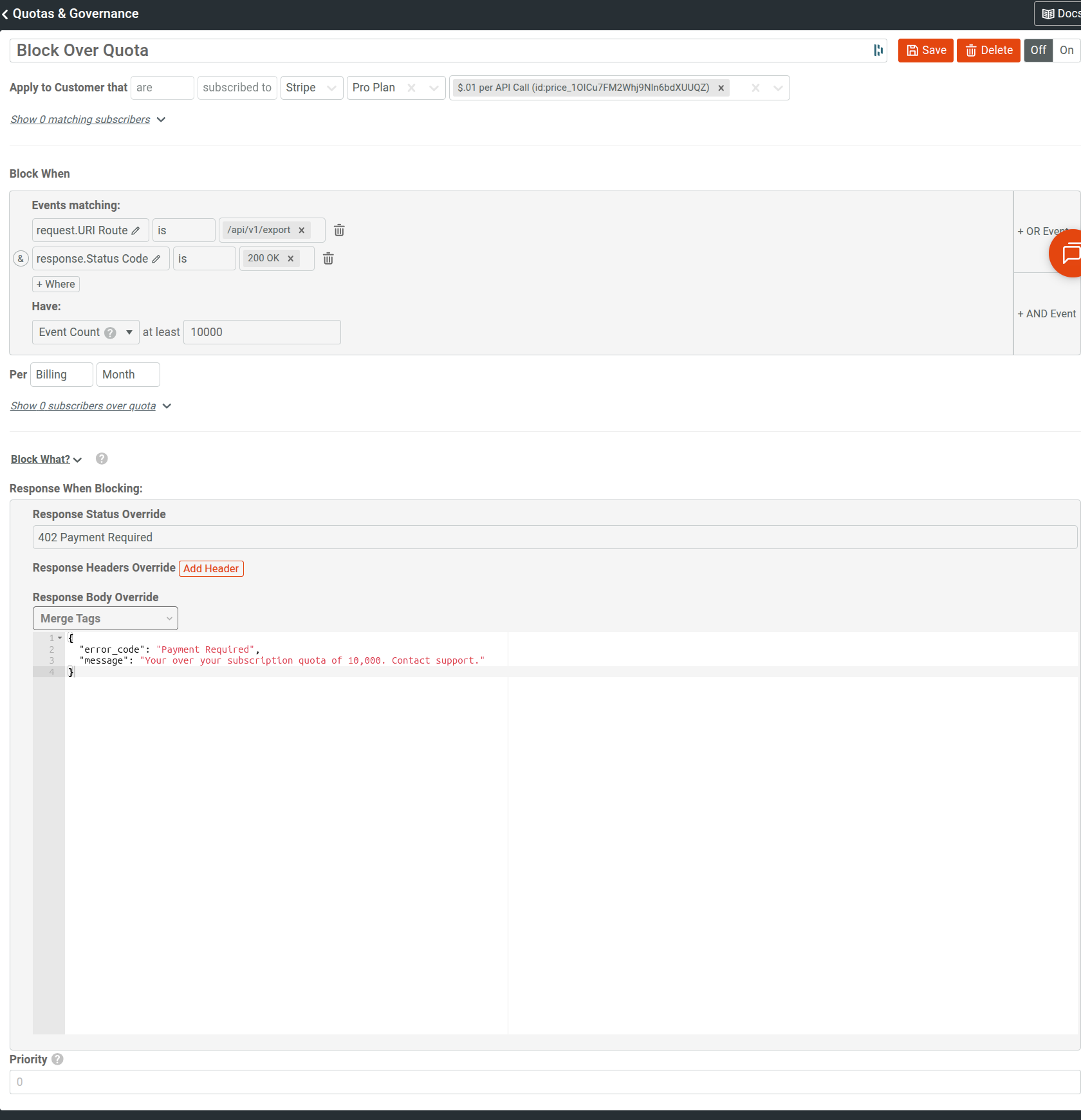
Provide Transparent Usage Reporting
You can share Moesif’s analytics with customers so they can view their own API usage in real time, with breakdowns by criteria like endpoints and billing periods. Moesif makes analytics data and visualizations available in different ways:
- Embedded metrics templates
- Search API for API and customer analytics
These features not only support different use cases but also promotes transparency for less billing disputes and easier vendor compliance checks.
Integrate with Billing Systems
Lastly, the metered usage must flow into invoices and revenue systems. To simplify that process, Moesif supports native integrations with popular billing providers like Stripe, Recurly, Zuora, and Chargebee. You can integrate custom billing solutions as well. Moesif keeps metering and billing decoupled from API; so you can easily experiment with monetization models and dispense with costly re-architecture.
Conclusion
Content has always been valuable, but in the LLM era, it has become a scarce and highly monetizable asset. Organizations that structure and productize their content using APIs are supporting digital experiences and driving the next wave of AI models. Content not monetized will still be consumed, just without any compensation. The urgency comes from the fact that model developers are aggressively sourcing data; early actors are setting market prices, standards, and licensing norms. So there are major opportunities to secure revenue and influence in a rapidly consolidating market.
 The Infrastructure for API-Based Content Monetization
14 day free trial. No credit card required.
Try for Free
The Infrastructure for API-Based Content Monetization
14 day free trial. No credit card required.
Try for Free






